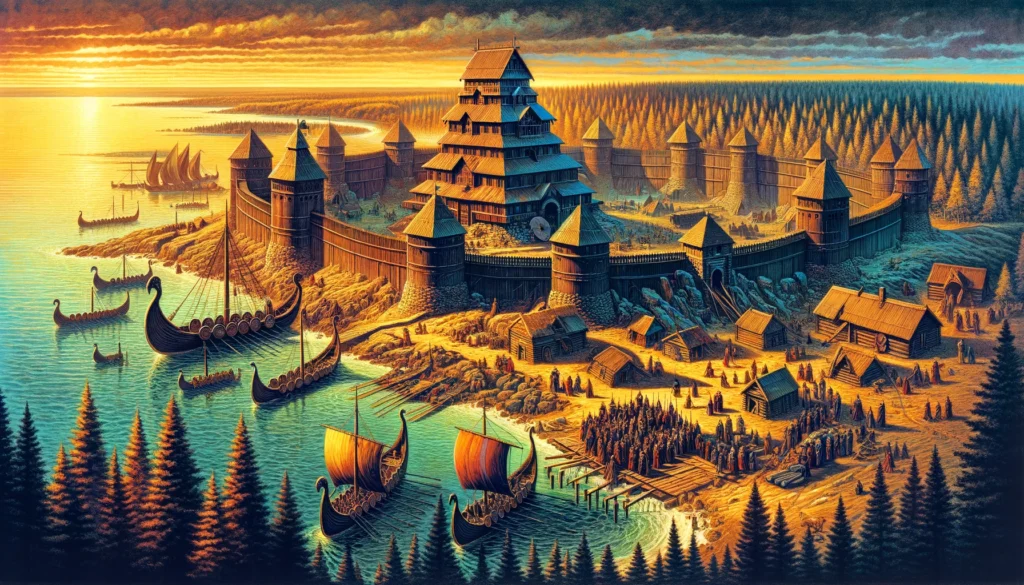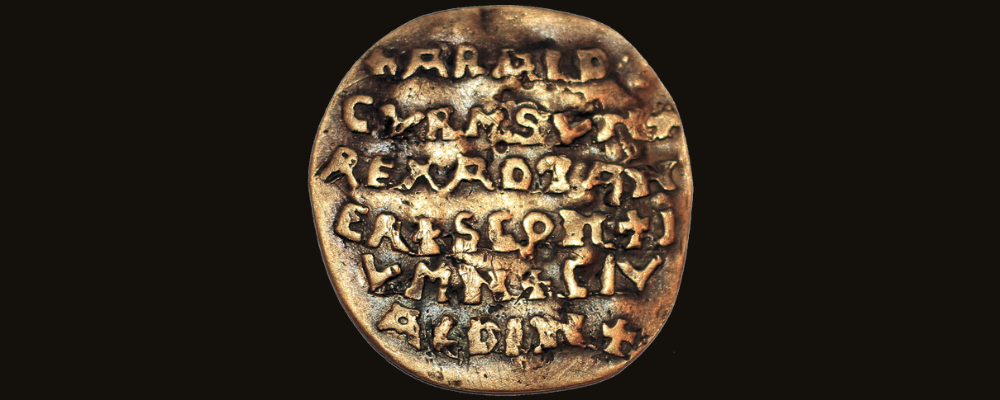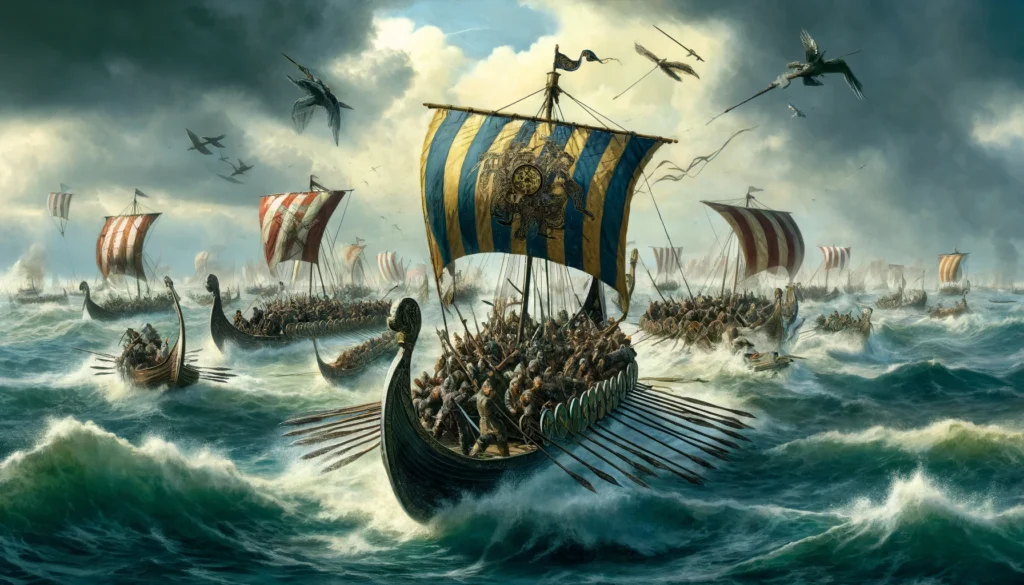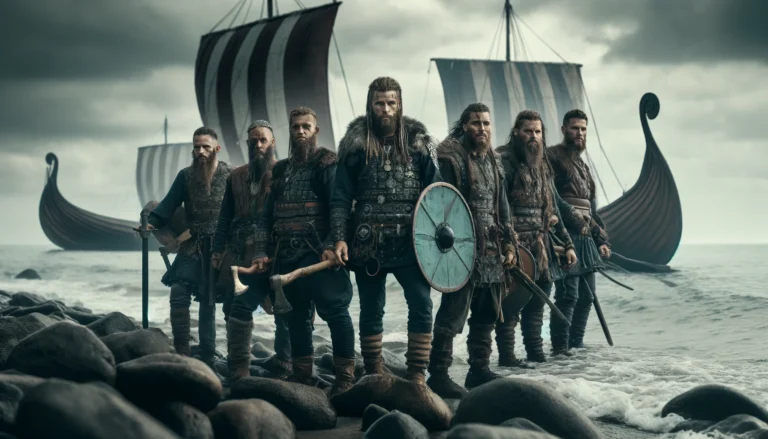While we think of the Vikings as legendary warriors, the Vikings themselves had their own legendary heroes and fighters.
There were the Berserker warriors believed to embody the spirit of the bear to become invincible in battle. Read our post on the Berserkers here.
And there were also the Jomsvikings.
The Jomsvikings were a semi-legendary band of Viking mercenaries believed to have been active in the 10th and 11th centuries.
They are also said to have held on to old Norse religious practices while the rest of the Viking world was converting to Christianity.
The Jomsvikings were probably a group of Danish Vikings who established a stronghold for themselves in modern Poland.
hey worked as mercenaries, fighting for the highest bidder.
They are also often seen as a precursor to many of the chivalric orders that emerged in the following centuries, such as the Knights Templar.
Eastern Warriors

Most of what we know about the Jomsvikings comes from the Jomsvikinga Saga, an Icelandic saga written in the 12th century, and in the Saga of King Olaf Tryggvason, who is said to have been betrayed by the Jomsvikings.
They are described as having a stronghold in the east, on the southern coast of the Baltic Sea, called Jomsborg.
It may be the same city that is called Jumne, Julin, and Vineta in other surviving sources.
Some archaeologists believe that the Jomsborg was located at Wolin in Poland.
Different sources say that there were between 30 and 300 ships docked in the stronghold, while others suggest that it was just a market town with a Danish garrison.
Several ancient rune stones seem to refer to battles that the Jomsvikings participated in.
So, while we don’t know where their stronghold was or if all the stories about them are true, the legends seem to be based on a real group of Viking fighters.
Live by the Code

The Jomsvikings are described as being very selective about who they allowed into their order, restricting membership to men who have proven their prowess on the battlefield, and aged between 18 and 50.
They would have to demonstrate their prowess to the brotherhood through an act of strength and valor, which was usually a duel with an existing Jomsviking.
Once admitted, the warrior had to live by a strict code. If they broke the rules, they were kicked out.
They were never allowed to show fear in the face of the enemy, and could never flee from a fight.
An orderly retreat was allowed if they were outnumbered by a superior force.
All spoils were split equally among the brothers.
The brothers were never allowed to speak poorly of one another, and they were honor-bound to defend their brothers and exact vengeance if any of them were killed.
Brothers were not allowed to leave the Jomsborg stronghold for more than three days without specific permission, and women and children were never allowed within the stronghold.
History of the Brotherhood

Timeline 1
One says that the area was conquered by King Harald Bluetooth of Denmark, who gave it to a Swedish prince called Styrbjorn the Strong, to whom he also provided forces.
They would go on to become the Jomsvikings and terrorize the seas.
The involvement of Harald Bluetooth seems to be confirmed by the discovery in 2014 of the Curmsun Disc in Sweden, a precious gold disc with a Latin inscription.
It describes Harald Bluetooth as the king of the Danes, Scania, Jomsborg, and the diocese of Aldinburg.
Styrbjorn the Strong was said to have led the Jomsviking at the Battle of the Fyrisvellir Uppsala in 984/5 against Eric the Victorious, in which the mercenaries suffered a terrible defeat as they tried to take the Swedish crown.
This is portrayed as an incredible turn of events because of the prowess of the Jomsvikings. It is explained by a pact for victory between Eric and Odin.
Timeline 2

Other sources offer a completely different history for the Jomsvikings that cover the same years.
They say that the order was founded by the Danish hero Palnatoke, who was introduced to the Black Sea by the Wendish ruler Burislav.
The Wends were a Slavic people living in northeast Germany. Palnatoke was then succeeded as leader of the Jomsvikings by Sigvaldi Strit-Haraldsson.
He was also said to be Danish and to have previously ruled over Scania.
He is also said to have led the Jomsvikings in an attack against the Norwegian King Haakon Sigurdsson, but they were defeated at the Battle of Hjorungavagr in 986.
In the Jomsvikings Saga, this defeat is described as the beginning of the end of the dominance of the Jomsvikings.
Sigvaldi also led the Jomsvikings in the Battle of Svolder in 1000, in which he ambushed Olaf Tryggvason due to his attempts to convert much of Norway to Christianity.
Olaf was defeated and presumed dead. But there are also stories that he swam to safety and started a new life.
Sigvaldi was succeeded by his brother Throkell the Tall, who was a foster father to Cnut the Great, who would go on to create the North Sea Empire.
He led a campaign to England in 1009, overrunning Southern England.
Final Defeat
According to the Heimskingla, King Magnus I of Norway decided to get rid of the Jomsvikings as part of his plans to consolidate his power over Denmark.
He reportedly sacked Jomsborg in 1043, destroying the city and killing most of its inhabitants.
Viking Archaeology at Wolin

The theory is that Jomsborg was located on Hangman’s Hill near Wolin, also known as Jom, in West Pomerania, Poland.
It is home to one of the largest early medieval cemeteries in northern Europe.
Archaeologists now believe they have found evidence of a ringfort on the hill, which was a classic stronghold fortification used by the Danish Vikings.
There is also evidence that the fortress was burned, which could align with the story of King Magnus I destroying Jomsborg.
The footprint of this settlement seems to be very similar to the known ancient Viking cities of Hebedy in Denmark and Birka in Sweden.
Unraveling the Mystery
The Jomsvikigs have long been a mystery for historians.
They are mentioned sparingly in the surviving sources and many stories conflict.
But this is a mystery that may soon be solved once further excavations are conducted at Wolin.







